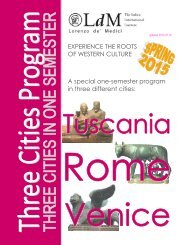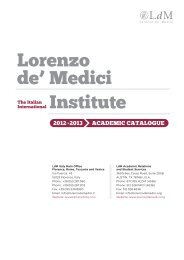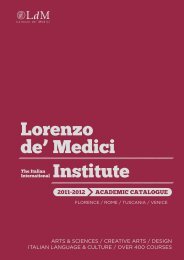aCademiC Catalog 2013-2014 - Lorenzo de Medici
aCademiC Catalog 2013-2014 - Lorenzo de Medici
aCademiC Catalog 2013-2014 - Lorenzo de Medici
Create successful ePaper yourself
Turn your PDF publications into a flip-book with our unique Google optimized e-Paper software.
ROME<br />
School of Creative Arts<br />
Culinary and Nutritional Arts<br />
Wine and Culture I: Wines of Italy<br />
NUH 170 R<br />
Cr: 3; Contact hrs: 45<br />
This course investigates Italian wine in the context of the<br />
extraordinary history, philosophy, culture and lifestyle of Italy.<br />
In this context wine is not only a much-loved drink but forms<br />
an essential part of rich cultural traditions extending back to<br />
the Etruscans and ancient Romans. From the study of wine<br />
we learn about the practices of earlier cultures, about their<br />
values and our own, and we gain a unique perspective on<br />
Italy today. The course focuses on the distinct traditions and<br />
economic, geographic and climatic aspects of each area of<br />
Italian wine production. Stu<strong>de</strong>nts explore grape varieties and<br />
different techniques used to make wine, and the national and<br />
regional classifications. They also subject representative wines<br />
to organoleptic analysis (visual, olfactory and gustative). Each<br />
wine is studied in terms of its characteristics, history and<br />
traditions, and in relationship to the particular foods meant to<br />
accompany it.<br />
Celebrating Italian Style: Food and Culture in<br />
Contemporary Italy<br />
NUH 200 R<br />
Cr: 3; Contact hrs: 45<br />
This course <strong>de</strong>als with the relationships between Italian<br />
traditions, folklore and contemporary Italian society, for example<br />
the links between festivals, food and wines, tourism and today’s<br />
Italian economy. Nowadays the image of Italy in the world is<br />
tightly connected with the global diffusion and promotion of<br />
its leading “Ma<strong>de</strong> in Italy” products, among which food and<br />
wines are the most important. The land of poor emigrants has<br />
become the land of class and style, Italian chefs are as popular<br />
as Italian fashion <strong>de</strong>signers, Italian wines feature among the<br />
best wines of the world, and Italian recipes have found their way<br />
to the world’s most renowned restaurants menus. This course<br />
will give stu<strong>de</strong>nts the opportunity to discover the reasons for<br />
this miracle through a wi<strong>de</strong> range of hands-on cooking lessons,<br />
wine and food tasting, field trips and guest lectures.<br />
Introduction to Nutrition Studies<br />
NUH 205 R<br />
Cr: 3; Contact hrs: 45<br />
The aim of this dietary education course is to provi<strong>de</strong> gui<strong>de</strong>lines<br />
and <strong>de</strong>velop critical thinking for a healthful diet and lifestyle.<br />
Inten<strong>de</strong>d for non-majors in science, the course addresses basics<br />
of the chemistry, biology and medicine of nutrition including<br />
the physiological principles that un<strong>de</strong>rlie a balanced diet and<br />
the correct uptake of nutrients. Particular emphasis is on the<br />
Mediterranean diet. Themes inclu<strong>de</strong>: nutrition requirements;<br />
nutrition and wellness; food sources and production; consumer<br />
choices; social dynamics that lead to eating disor<strong>de</strong>rs such<br />
as anorexia and bulimia among young people; the effects of<br />
excessive weight on health; obesity in western societies.<br />
Italian Cuisine: History and Practice<br />
NUH 250 R<br />
Cr: 3; Contact hrs: 45<br />
This course focuses our attention on the amazing history of<br />
Italian cooking, from ancient Rome to today. Food will be<br />
examined in the historical context of each period and in relation<br />
to the society and culture of the time. As an ancient Italian<br />
saying goes, “Tell me what you eat, and I will tell you who you<br />
are”. Food and culture go hand in hand in every culture and<br />
society. Italy is a variegated country, it displays the greatest<br />
genetic variety of any European country and this expresses<br />
itself in a corresponding cultural variety. The course is therefore<br />
highly recommen<strong>de</strong>d for stu<strong>de</strong>nts of Italian culture, as they will<br />
learn the hands-on traditions of cooking and taste through the<br />
ages. No matter which region an Italian calls home, the same<br />
love of food prevails.<br />
Film, Vi<strong>de</strong>o and Multimedia<br />
Production<br />
Italy on the Radio<br />
FVM 230 R; Dual listed: COM 230 R<br />
Cr: 3; Contact hrs: 45<br />
This course on radio journalism in Italian context is divi<strong>de</strong>d into<br />
two parts. In the first part stu<strong>de</strong>nts learn about contemporary<br />
Italy from a variety of relevant perspectives, in or<strong>de</strong>r to help<br />
them un<strong>de</strong>rstand current issues in Italy, some of which will<br />
feature in the radio work to be un<strong>de</strong>rtaken during the second<br />
part of the course. Excerpts from newspapers, magazines<br />
and other media will be analyzed in class, in or<strong>de</strong>r to provi<strong>de</strong><br />
stu<strong>de</strong>nts with the necessary tools to <strong>de</strong>velop stories and reports<br />
by themselves on any contemporary subject. In the second<br />
part of the course stu<strong>de</strong>nts will attend hands-on classes in the<br />
Eco Radio studios, held by professional radio journalists and<br />
producers. Stu<strong>de</strong>nts will be introduced to the world of radio<br />
communications, its history and functioning, the different jobs,<br />
techniques and technologies used, and will create and record a<br />
radio program to be broadcast weekly on Eco Radio.<br />
Painting, Drawing and Mixed<br />
Media<br />
Principles of Drawing and Composition<br />
PDM 130 R<br />
Cr: 3; Contact hrs: 60<br />
This course will teach the basic techniques of figure and<br />
object drawing. The program is <strong>de</strong>signed to introduce the<br />
fundamental principles and elements of drawing as well as the<br />
major techniques and media. Each lesson has a specific aim<br />
and forms part of a progressive build up of skills. Stu<strong>de</strong>nts will<br />
be introduced to the fundamental principles and elements of<br />
drawing using charcoal, pencil and various other media. The<br />
aim of the course is to <strong>de</strong>velop a better un<strong>de</strong>rstanding and<br />
knowledge of drawing, and to encourage further studies.<br />
Foundation Oil Painting<br />
PDM 140 R<br />
Cr: 3; Contact hrs: 90<br />
This is a course for beginning stu<strong>de</strong>nts or stu<strong>de</strong>nts with no<br />
previous training in Fine Arts wanting an introduction to the<br />
traditional techniques of oil painting. The course <strong>de</strong>als with<br />
the most fundamental principles and elements of still-life<br />
painting, with an emphasis on the perception and build up of<br />
form, tone, and color on a two-dimensional surface. Exercises<br />
will be introduced to stu<strong>de</strong>nts in highly structured lessons,<br />
supplemented by practical <strong>de</strong>monstrations. The aim of the<br />
course is to give stu<strong>de</strong>nts the basic knowledge of techniques<br />
in oil painting.<br />
Foundation Oil Painting (Summer only)<br />
PDM 141 R<br />
Cr: 3; Contact hrs: 60<br />
This is a course for beginning stu<strong>de</strong>nts or stu<strong>de</strong>nts with no<br />
previous training in Fine Arts wanting an introduction to the<br />
traditional techniques of oil painting. The course <strong>de</strong>als with<br />
the most fundamental principles and elements of still-life<br />
painting, with an emphasis on the perception and build up of<br />
form, tone, and color on a two-dimensional surface. Exercises<br />
will be introduced to stu<strong>de</strong>nts in highly structured lessons,<br />
supplemented by practical <strong>de</strong>monstrations. The aim of the<br />
course is to give stu<strong>de</strong>nts the basic knowledge of techniques<br />
in oil painting.<br />
Introduction to Pastel Techniques<br />
PDM 170 R<br />
Cr: 3; Contact hrs: 60<br />
This course introduces stu<strong>de</strong>nts to the various pastel techniques<br />
such as wax, watercolor, stabilo soft, stabilo tone. Stu<strong>de</strong>nts are<br />
also introduced to the various artists who have used pastel<br />
techniques as their chosen medium. The course inclu<strong>de</strong>s<br />
subjects from still-life to mo<strong>de</strong>ls.<br />
148<br />
LdM Aca<strong>de</strong>mic <strong>Catalog</strong> <strong>2013</strong>-<strong>2014</strong>





